Trade
Event Report
***********************************
2004 Media Summit, + + + +
By Al Berrios (contact
Al Berrios)
Unlike last week's Latino Media conference, this event, presented by McGraw-Hill on Feb 9 & 10 was much, much better. Although light on insights, it was a total shmooze-fest. The information presented here was definitely high-level, because if you're not busy running a major company, you've read it all in the trades. Busy execs go to these things to hear this stuff like it's fresh, but of course, to meet and greet. For the sheer executive-ness of it, it merits 4 pluses, + + + +. Here are the highlights:
Skip to Section >>
> The
Broadcast Advantage or the Network Dominance Niche
> Urban Entertainment & Media Masters of the Universe
> The Globalization of the Entertainment, Advertising
and Marketing Services Industries…It's a small world after all
> Keynote Roundtable - Industry Leaders on the State
of the Media, Entertainment and Technology Industries
> Consumer Electronics Revolutionize the Media
and the Retail Marketplace
> Digital Cable & Satellite Television Strategies:
Channel Launches, SVOD-VOD, HDTV, International and Interactive
The
Broadcast Advantage or the Network Dominance Niche
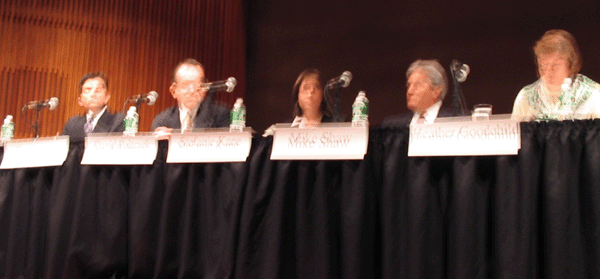 (Editor's
Note: fuzzy... we know... sorry... I take crappy pictures.)
(Editor's
Note: fuzzy... we know... sorry... I take crappy pictures.)
The same old argument - is broadcast TV so critical to marketing communications in a fragmented media universe? The answer, unquestionably, is still yes. Why, if television ratings and share continue to diminish over time? Why, if audiences have cable, internet, magazines, and other media choices? Why, if TV rates have increased to ludicrous heights without justification?
Because you can't beat its reach, and if you're a mass-market brand, niche ain't gonna do it alone. Reach is attracted with $12 billion worth of content (a.k.a. brands) produced annually just for TV, and kept because of a monopoly over basic, over-the-air spectrum granted to them broadcasters by the FCC. Even niche cable programmers are modifying their content towards more broad-based fare in an attempt to capture more advertiser interest.
But most amazing, because broadcast media is purchased for advertisers with cost-minimizing strategies, it can actually yield cost savings between upfront (that one time of the year in the summer) and scatter purchasing (purchasing throughout the year), in proportion to the total number of people you want to reach. In other words, you can either spend your entire family budget on that one big sale at the local supermarket or buy selected sale items throughout the month in the hopes of ending up having paid less overall. It's all based on supply and demand of attractive content, available budgets, and advertisers' willingness to take these sort of risks on content and demand throughout the year.
I find it interesting that in every instance I've heard one of these arguments, it's David Poltrack, EVP of Research & Planning for CBS, always defending his employer and the industry. I'd say a full 45% of his time is spent on the defensive, which is a waste of his time, since he should be spending more of it coming up with solutions, not explanations.
One possible solution (or explanation, depending on which side you're on) DVRs ain't the end. Turns out, according to CBS research, that consumers use them to sample programming, albeit, without sampling ads. This knowledge helps in understanding future content consumption and advertisement development.
Out of the entire panel, the one thing I found most disturbing, or perhaps a wide-open opportunity, is interconnects. Interconnects is what allows cable operators to reach different markets. Unlike spectrum which has to be picked up by antennas mostly pre-built into every TV set, cable is terrestrial based, and plugged into individual homes via interconnects. Cable operators are regional because of this system, and in order for a cable network to appear in homes on the East and West coast, they have to deal with individual cable operators across the country (called affiliates or multi-system operators).
Anyway, cable operators have spent so much time in presenting themselves as wide-reaching counterparts to broadcast networks, launching internet, VOIP, DVRs and VODs to diversity revenue, and launching their own networks to save costs on buying content from branded networks, few have taken advantage of their locality for attracting advertiser interest. Merrill Lynch believes theirs $27 billion out there waiting to be made from local advertising via interconnects and the only one making it is Comcast (at $1 billion per year). There's such poor management of assets, Comcast will very likely become the ruler of interconnect advertising as well.
Urban Entertainment & Media Masters of the Universe
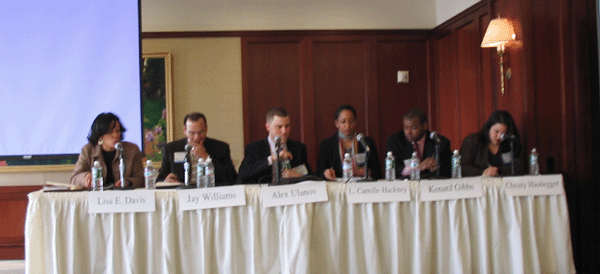
This panel was regrettably a big waste of time. The entire session was spent in defining "urban", which isn't really about black people, but is. Although there were some pretty impressive titles, only one delivered any serious and meaningful insight, (even more regrettably, he was from another consulting firm which shall remain nameless in this publication.)
I don't want to claim to have the definitive definition of what is urban, except to say that businesses should never stop redefining consumers as the success of their business depends on this constant evolution of your relationship with consumers. The urban consumer is now worth close to a trillion bucks. Although trends are predominantly lead by the entertainment segment (i.e. music, which consequently make radio a leading medium), male fashion and sports have exploded as another expression of how "urban" consumers want to be. Next up, electronics, autos, beverage, and finance, thanks to celebrity endorsement and the urban consumers that follow them.
The Globalization of the Entertainment, Advertising and Marketing Services Industries…It's a small world after all
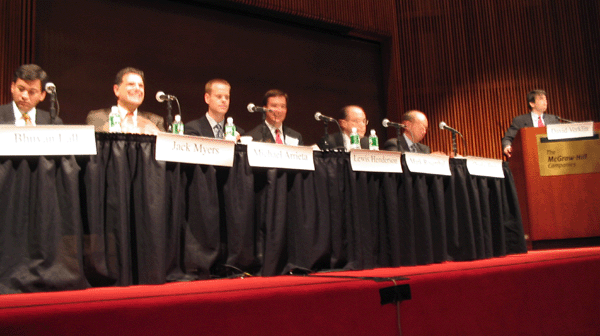
The only thing that made this panel interesting was the moderator, David Verklin, CEO of Carat, a very large media buying firm, with relationships with each panelist. His closeness gave the panel a very comfortable personality that put the audience at ease and made the discussion easier to digest. Was anything new? No. The only real international perspective came from a panelist from India and MTV's COO, Mark Rosenthal, who basically supported everything the Indian panelist said.
It was at this point that the conference started showing it's true colors - employer-buffet for very hungry MBAs. They just sprang up from nowhere, brandishing NYU, Wharton, and Harvard on their badges, and surrounding speakers like obsessed groupies, preventing vultures like me from pitching. It toughened me up for the remainder of the conference.
Keynote Roundtable - Industry Leaders on the State of the Media, Entertainment and Technology Industries
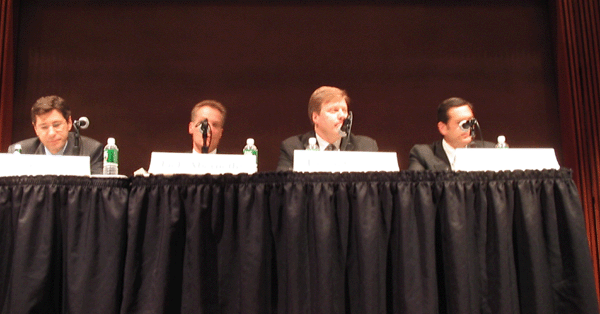
I thought things were going to get "kicked up a notch" during this panel. It was the keynote, featuring presidents from AOL, HBO, Clear Channel, and FOX News. But cooler still was the fact that Robert Friedman, the ousted CMO/COO of AOL Time Warner was the moderator. I thought this guy was going to be every bit as controversial as the press had lead me to believe 4 years ago, when you couldn't open up the Journal and read about his issues.
Well, Bob turned out to be such a disappointment. Upon seeing him, he looked like Tom Wolzien, the media analyst for Sanford Bernstein (another celeb in his own right, as he's quoted everywhere and sits on virtually every panel in the industry). If he had or has a temper, it's due to his diminutive stature, and I understand why he rubbed so many people the wrong way. Bob actually turned out to be a really nice guy, but unfortunately turned the panel into just another notch on their resumes for his old AOL TW buddies. At least I got pictures.
Consumer Electronics Revolutionize the Media and the Retail Marketplace
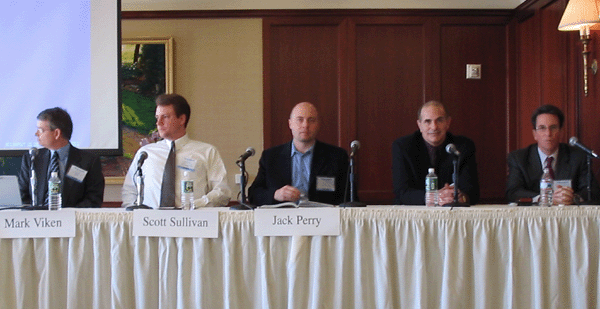
After spending an entire day discussing content, the next day I came to hear the guys that make it all really happen - the electronics manufacturers. Represented was Sony, Panasonic, Shure, Palm, and some company that facilitates digital transmission and reception of television content (unfortunately, his name and company wasn't printed on the program)
I sensed a frustration from the panelists at the U.S.'s snail-like pace at adopting standards and gizmos that are already dated throughout the more enlightened parts of the world, like S. Korea, Japan, Europe.
However, the guy with the digital transmission company, Jack Perry, made a comment that was pretty much the sentiment of the panelists, and unfortunately sounded like the death of civilization as we know it: [paraphrase] "We help consumers manage their time better by allowing them to watch more television."
Electronics is all about increasing productivity, even if that means allowing consumers to waste an increasing amount of their lives in front of the "boob-tube".
A key insight I got from this panel was their research into consumers' interests in collecting and archiving content. Almost all the panelists understood this need and exploited it in one way or another.
A serious problem I felt the problem had was the moderator from the Consumer Electronics Association, who spent more time talking about himself than allowing the panelists to speak.
Digital Cable & Satellite Television Strategies: Channel Launches, SVOD-VOD, HDTV, International and Interactive
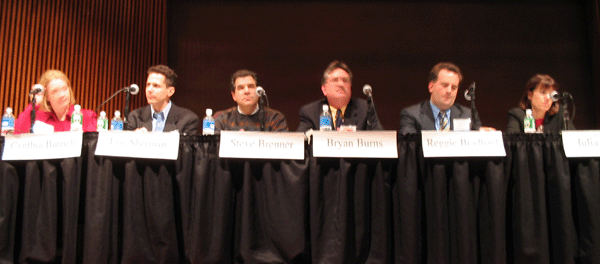
A long ESPN commercial, this panel offered nothing new. But at least I finally got the jump on some of those pesky MBAs!
The ESPN rep basically dominated the conversation because of their high rates to carriers of their programming, their recently cancelled original program, "Playmakers", and the launch of their new state-of-the-art facilities in Con. The next day, Comcast launched its bid for ESPN's parent, Disney, and many believe (including myself) owning ESPN was a major factor.
Overall, the pricey two-day
conference was like going to pricey grad school - it's not what you learn, it's
who you meet. Information presented here could have easily been picked up by
reading the trades, going to cheaper events, or just reading the paper everyday
and forming your own views. Sure it's nice to have your opinions validated every
now and then, and this event certainly did that for some execs I spoke to, however,
the real value of the fee was to meet and greet with some of the biggest big-wigs
in the industry. The McGraw-Hill building as a venue was also interesting. They
have a very nice and comfy auditorium on the mezzanine level (which I thought
was problematic for taking notes), but the conference was divided into two spaces,
the second being on the 50th floor that you had to cross half a block to get
to the elevator banks. Although better lit and with tables for better note-taking,
it required 30 minute intervals between hour and a half sessions just to make
sure everyone mingled, ate some appetizers, and still made it to their room
in time. Four pluses, + + + +.
RELATED
AL BERRIOS & CO. ARTICLES
> "83% Prefer Sony and Only 6.8% Prefer Samsung"
Disclaimer:
The recommendations, commentary and opinions published herein are based on
public information sometimes referenced via hyperlinks. Any similarities or
likeness to any ideas or commentary from any other sources not referenced
is purely coincidental. al berrios & co. cannot control any results occurring
from advice obtained from this publication nor any opinion(s) conveyed by
any reader of this publication.
(c) 2001-2005. All Rights Reserved. al berrios & company, inc. Published
by al berrios & co. This Report may not be reproduced or redistributed
in any form without written permission from al berrios & co., subject
to penalty.